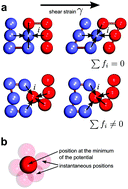Parameter-free predictions of the viscoelastic response of glassy polymers from non-affine lattice dynamics†
Abstract
We study the viscoelastic response of amorphous polymers using theory and simulations. By accounting for internal stresses and considering instantaneous normal modes (INMs) within athermal non-affine theory, we make parameter-free predictions of the dynamic viscoelastic moduli obtained in coarse-grained simulations of polymer glasses at non-zero temperatures. The theoretical results show very good correspondence with rheology data collected from molecular dynamics simulations over five orders of magnitude in frequency, with some instabilities that accumulate in the low-frequency part on approach to the glass transition. These results provide evidence that the mechanical glass transition itself is continuous and thus represents a crossover rather than a true phase transition. The relatively sharp drop of the low-frequency storage modulus across the glass transition temperature can be explained mechanistically within the proposed theory: the proliferation of low-eigenfrequency vibrational excitations (boson peak and nearly-zero energy excitations) is directly responsible for the rapid growth of a negative non-affine contribution to the storage modulus.



 Please wait while we load your content...
Please wait while we load your content...